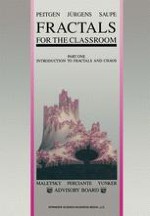1992 | OriginalPaper | Chapter
Limits and Self-Similarity
Authors : Heinz-Otto Peitgen, Hartmut Jürgens, Dietmar Saupe
Published in: Fractals for the Classroom
Publisher: Springer New York
Included in: Professional Book Archive
Activate our intelligent search to find suitable subject content or patents.
Select sections of text to find matching patents with Artificial Intelligence. powered by
Select sections of text to find additional relevant content using AI-assisted search. powered by
Dyson is referring to mathematicians, like G. Cantor, D. Hilbert, and W. Sierpinski, who have been justly credited with having helped to lead mathematics out of its crisis at the turn of the century by building marvelous abstract foundations on which modern mathematics can now flourish safely. Without question, mathematics has changed during this century. What we see is an ever increasing dominance of the algebraic approach over the geometric. In their striving for absolute truth, mathematicians have developed new standards for determining the validity of mathematical arguments. In the process, many of the previously accepted methods have been abandoned as inappropriate. Geometric or visual arguments were increasingly forced out. While Newton’s Principia Mathematica, laying the fundamentals of modern mathematics, still made use of the strength of visual arguments, the new objectivity seems to require a dismissal of this approach. From this point of view, it is ironic that some of the constructions which Cantor, Hilbert, Sierpinski and others created to perfect their extremely abstract foundations simultaneously hold the clues to understanding the patterns of nature in a visual sense. The Cantor set, Hilbert curve, and Sierpinski gasket all give testimony to the delicacy and problems of modern set theory and at the same time, as Mandelbrot has taught us, are perfect models for the complexity of nature.
